The friars most loved by the City
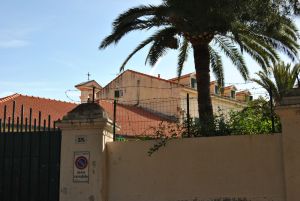 The origins of the settlement of a community of Capuchin fathers in Sanremo date back to 1578, when, following an express request from the Matuzian municipal authorities three years earlier, some Capuchins arrived in the city, who were temporarily housed in the house of the Fabiani lords or, according to others, in the old oratory of Santa Brigida, while, shortly afterwards, they moved to a house near the chapel of the Madonna della Costa.
The origins of the settlement of a community of Capuchin fathers in Sanremo date back to 1578, when, following an express request from the Matuzian municipal authorities three years earlier, some Capuchins arrived in the city, who were temporarily housed in the house of the Fabiani lords or, according to others, in the old oratory of Santa Brigida, while, shortly afterwards, they moved to a house near the chapel of the Madonna della Costa. 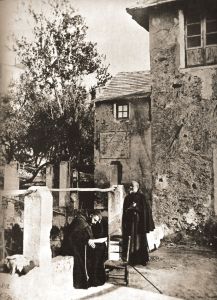 Since 1578 the Municipality had granted them a piece of land owned by the Sapia family, situated at the top of the Costiglioli hill, where work began on the construction of a new convent, which was dedicated to Saint Bernard.
Since 1578 the Municipality had granted them a piece of land owned by the Sapia family, situated at the top of the Costiglioli hill, where work began on the construction of a new convent, which was dedicated to Saint Bernard.
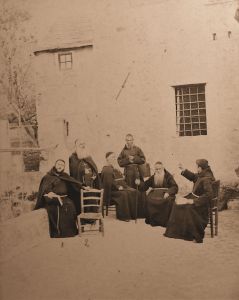 Once the works were completed in a few years, on 17th September 1590 the Bishop of Albenga Luca Fieschi could consecrate the new church and the first guardian father was Agostino da Genova.
Once the works were completed in a few years, on 17th September 1590 the Bishop of Albenga Luca Fieschi could consecrate the new church and the first guardian father was Agostino da Genova.
However, some water infiltrations in the foundations caused worrying cracks in the building that had just been completed, so much so that many citizens were convinced of the need to move the convent to another location. However, all the initiatives in this sense had to stop after the outbreak of the first war between Genoa and the Savoys in 1625, but a miraculous event occurred unexpectedly to further accelerate the intention to relocate. On 7th July 1627, in fact, on the occasion of the feast of St. Syrus, a large banner was seen appearing above the convent, on which a Crucifix was painted, causing deep apprehension among the citizens and inducing the friars themselves to definitively abandon the old monastery of salita Costiglioli, which already had several cracks, in 1630, to move to a new and larger building.
Thanks to the substantial contributions of some generous benefactors and the collaboration of the Municipality, it was thus possible to purchase a vast piece of land west of the city 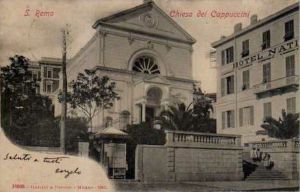
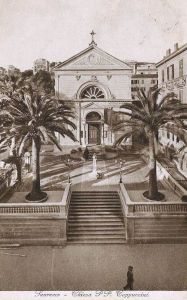 to build the new monastery. On 30 November 1641 the Bishop of Albenga Pier Francesco Costa consecrated the first stone of the new building in the presence of the highest provincial authorities of the Order. Nine years later the church and the adjoining convent were almost finished, so much so that the complex lacked only the water cistern.
to build the new monastery. On 30 November 1641 the Bishop of Albenga Pier Francesco Costa consecrated the first stone of the new building in the presence of the highest provincial authorities of the Order. Nine years later the church and the adjoining convent were almost finished, so much so that the complex lacked only the water cistern.
In the following years work was undertaken to complete the church, which was consecrated on 27 May 1668 by the Bishop of Albenga Tomaso Pinelli. The new church, dedicated like the previous one to the saints Bernardo Abate and Francesco d'Assisi, was later also dedicated to the Immaculate Conception.
In June of the same year, the friars obtained a new bell for their church by order of the Town Council, which ordered its transfer from the Hermitage of San Romolo, while three years later the municipal authorities allocated a large sum for the road system in the area, where the old road was widened and a new one was opened, also equipped with a door, called "Porta dei Cappuccini", which became the westernmost in the town.
Around 1685, however, there were some lesions on the façade of the building, so much so that it was necessary to reinforce the undercuts along the perimeter and under the internal walls of the church, which thus reached a definitively stable structure. In the decades following its construction, the church, while remaining 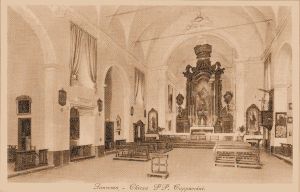 particularly austere in keeping with the Franciscan spirit, was embellished with a monumental Baroque wooden altar in pure monastic style, some paintings by unknown artists, wooden balustrades, the statue of the Immaculate Conception, the chapel of St. Erasmus and a characteristic nativity scene.
particularly austere in keeping with the Franciscan spirit, was embellished with a monumental Baroque wooden altar in pure monastic style, some paintings by unknown artists, wooden balustrades, the statue of the Immaculate Conception, the chapel of St. Erasmus and a characteristic nativity scene. 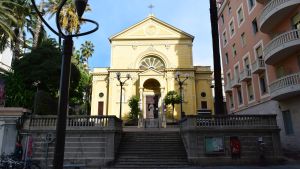 In 1755 the high altar was renovated, while inside the church there were several private chapels for the burial of members of some of the oldest and most prestigious families of the city, such as the Sapia Rossi, Roverizio, Borea d'Olmo, Sardi and Verde, whose tombs are flanked by those of the friars themselves.
In 1755 the high altar was renovated, while inside the church there were several private chapels for the burial of members of some of the oldest and most prestigious families of the city, such as the Sapia Rossi, Roverizio, Borea d'Olmo, Sardi and Verde, whose tombs are flanked by those of the friars themselves.
After the revolutionary and Napoleonic period, during which the Capuchins were driven out and their monastery closed by authority, after the fall of Napoleon the friars were able to return to their convent and the adjacent church, which had to be suitably restored for the damage suffered during the long period of forced closure.
New sacred vestments were then purchased and work was carried out to restore the structure, partly financed by Angelo Capoduro, to whom the friars allowed in 1822 to place a tomb for him and his family inside the church as a sign of gratitude for his active contribution to the renovation of the sacred building.
In 1837 the Capuchins of Sanremo, led by Father Giuseppe Vaggi, distinguished themselves in their work to help the local population dramatically affected by a very serious cholera 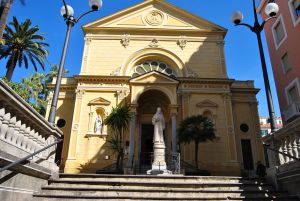 epidemic, while in 1855 part of the friars' garden had to be sacrificed for the enlargement of the road trunk flanking the Franciscans' cloister, whose properties were almost entirely
epidemic, while in 1855 part of the friars' garden had to be sacrificed for the enlargement of the road trunk flanking the Franciscans' cloister, whose properties were almost entirely 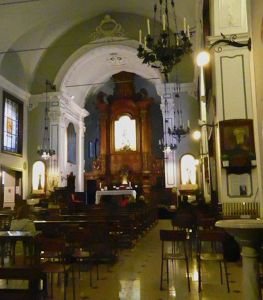 forfeited in the same year by the State.
forfeited in the same year by the State.
After purchasing a piece of land to the west of the church, the superior of the convent, Father Candido, had a new building erected there from 16 June 1876, to which Senator Ernesto Marsaglia contributed financially. The structure housed the Sanremo friars for a few years, flanked since 1890 also by the Capuchin tertiary nuns.
In 1883 the mayor Bartolomeo Asquasciati, however, ordered the temporary use of the monastery as barracks of the Bersaglieri, forcing Father Candido to raise the building one more floor to accommodate his brothers.
In 1897, following the decision of the municipal administration to build a Casino in the area partly occupied by the Maria Vittoria public gardens, the friars had to give up their vegetable garden with the adjoining convent, which was demolished to make way for the new Casino. 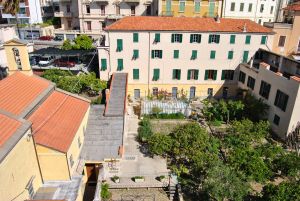 Once the church had been saved, which - according to the initial plan of the Casino's designers - was to be demolished, thanks above all to the intervention of Father Francesco da Fivizzano, who managed to have the decision annulled, at the end of 1898 construction work began on the new monastery, designed by architect Pio Soli and located in the area to the east of the church, whose external façade was modified at the same time.
Once the church had been saved, which - according to the initial plan of the Casino's designers - was to be demolished, thanks above all to the intervention of Father Francesco da Fivizzano, who managed to have the decision annulled, at the end of 1898 construction work began on the new monastery, designed by architect Pio Soli and located in the area to the east of the church, whose external façade was modified at the same time.
In 1926, on the occasion of the solemn celebrations for the seventh Franciscan centenary, a marble statue of St. Francis of Assisi made by the sculptor Vincenzo Pasquali was finally placed in the square in front of the church.
(sources: texts by Andrea Gandolfo, Ernesto Porri; images from private archives)




